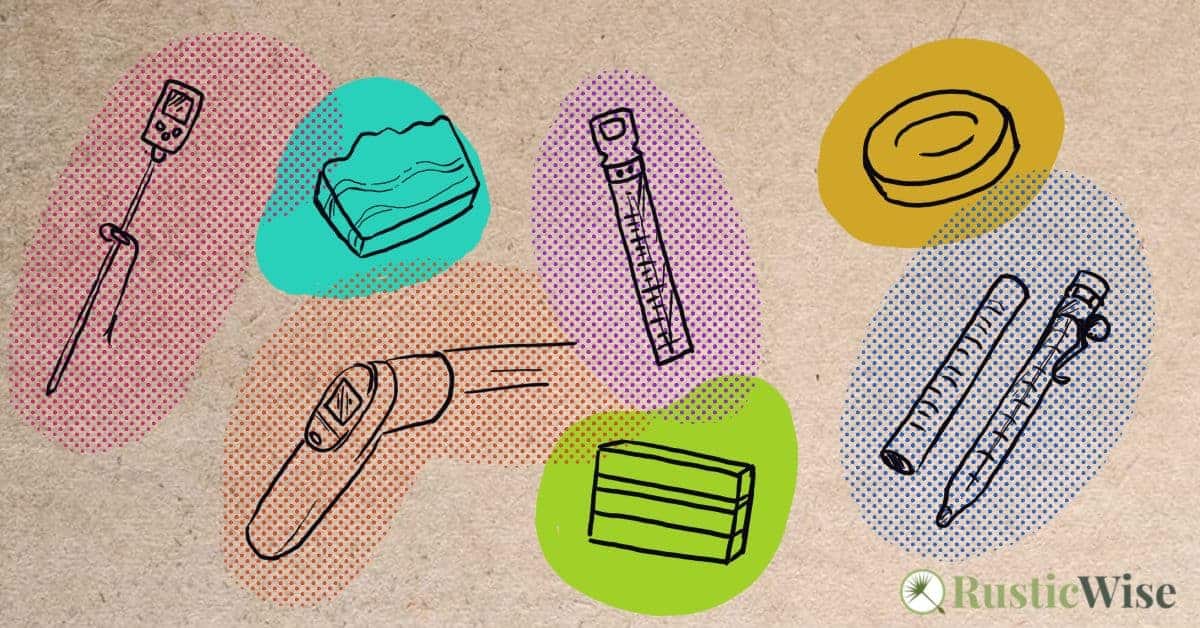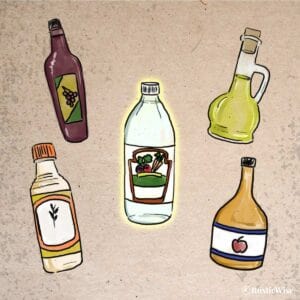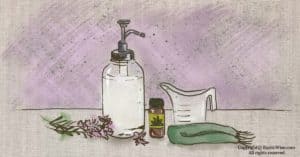Your Ultimate Guide to the Best Thermometer for Soap Making

RusticWise is supported by its readers. When you purchase through links on our site, we may earn an affiliate commission. As an Amazon Associate, we earn from qualifying purchases. Thank You!
If you’re stocking up on soap making supplies, you might wonder, what’s the best thermometer for soap making? In my opinion, the best bet is an infrared thermometer—mess-free and accurate temperature reading at the push of a button. If that’s not in your budget, a simple, yet reliable candy thermometer also works great.
Read on to learn more about several main types of thermometers for making soap, along with the pros and cons of each. We’ll also share key features to look for when shopping for a soap making thermometer.
Do you really need a thermometer for soap making?
People often ask, can you make soap without a thermometer?
If you want reliably great batches of cold process or hot process soap, a thermometer is an essential tool that helps achieve consistency and raise the level of your soap making skills.
Soap making is part art and part science—a thermometer helps you get the temperature juuuuust right.
Sure, there are some soapers who never, or rarely, use thermometers and still churn out good batches of handmade soap. (If this is you, kudos!)
My guess is that people who don’t use thermometers are:
a) Very experienced and have developed an instinct of when to mix lye water and oils;
b) Have made the same recipe again and again;
c) Both A and B; or,
d) Might make melt-and-pour soap, which is less finicky as the lye is already incorporated.
Using a thermometer is especially useful if you’re new to this craft and want to get familiar with the temperature of the lye mixture and the fats/oils before mixing.
Even if you’re a seasoned soapmaker, having a thermometer is handy to double-check your numbers.
What can happen if you don’t use a thermometer to make soap?
Some soap recipes which use milk, juice, or honey can be more finicky. When soap mixtures are too hot, you take the risk of burning the liquid.
Other times when lye and oils are mixed at very high temperatures, the soap develops cracks. Sometimes when you add certain fragrance oils or essential oils when the mixture is very hot, your soap may seize (harden quickly and unexpectedly)¹.
When the lye and oil mixtures are too cold, you might end up with a coating of white powder over the bar of soap (also known as soda ash). The soap mixture could also take a very long time to reach trace.
Main types of thermometers for soap making
While there are many types of thermometers used in the culinary world, two types standout as the best for soap making: infrared thermometers and candy thermometers.
Which type you ultimately end up using depends mostly on your preferences and budget.
Here’s a closer look at the pros and cons of each.
Infrared thermometer
Also known as an infrared temperature gun, these digital contraptions are quick and easy to use. To “pull the trigger” or read a temperature, simply point the scanner where you want to get a temperature reading, then press and hold the button. There’s no direct contact needed.
You can find these at most local home hardware stores.
We have one of these at home, and they are so handy and easy to use.
Tip: When using an infrared thermometer, remember that it only takes the surface temperature and not the internal temperature. A good practice is to stir the mixture first before taking the temperature to get a more accurate reading².
Pros of infrared thermometers:
- No-mess: Making soap is already a messy hobby, and having one less thing to wipe and clean is great. Infrared thermometers require no contact with the surface you’re measuring.
- Easy to use: Just point-and-shoot the infrared scanner where you need it. There’s no need to clip it to the side of a boiling pot like a candy thermometer.
- Precise: You can take an accurate temperature of the center of your oil mixture, on the outside of the pot, etc.
- Wide temperature range: While each model differs, many models can read a wide range of temperatures from -4° and 600 degrees Fahrenheit (-20 and 316 degrees Celsius). This is really much more than you need when making homemade soap.
- Easy to read: The digital display screen provides large numbers so you don’t have to squint.
Cons of infrared thermometers:
- Cost: If you’re new to soap making and aren’t sure you’ll be making many bars of soap, the cost can seem prohibitive.
- Battery-operated: Anything with batteries has the potential to die when you need it the most.
You might like
Etekcity Infrared Thermometer 1080 Digital Temperature Gun
- Measure surface temperature ranging from -58℉ to 1022℉/-50℃ to 550℃.
- Response time: ≤500Ms.
- Number of Batteries: 1 AAA batteries required (included).
Found on Amazon
Check Current Price
Those in Canada and the UK should be taken to the product listing in your region.
Candy thermometer
Made of tempered glass and/or stainless steel, candy thermometers capture the high temperatures many candy and jelly recipes require. Since the art of making (good) candy requires precise monitoring of bubbly sugary mixtures, this makes candy thermometers a great tool for making soap.
Candy thermometers come in analog or digital versions.
Classic analog candy thermometers are immersed in the hot liquid and should have a clip to hold it to the side of the pot.
Digital candy thermometers have a stainless steel probe that you place in the hot liquid. Some digital thermometers are instant-read. Pop an instant-read thermometer into your liquid to take a quick temperature reading in a few seconds (these are not intended to be left in the liquid). Some digital candy thermometers have a clip to affix to the side of the pot.
You might like
Polder Candy/Jelly/Deep Fry Thermometer Stainless Steel with Pot Clip
- Temperature ranges in Celsius and Fahrenheit – 90°F to 400°F (30°C to 200°C).
- Pot clip attachment clips to side of pot and securely holds thermometer in place for precise readings.
- Dishwasher safe, top rack only.
Found on Amazon
Check Current Price
Those in Canada and the UK should be taken to the product listing in your region.
Pros of analog candy thermometer³:
- Cost-effective: Many basic analog candy thermometers range in price from $5 to $10. At this affordable price, you can afford to pick up at least two (which is handy for soap making).
- Good temperature range: Many analog candy thermometers have a range of 100–400 degrees Fahrenheit (38–204 degrees Celsius).
- Durable: Maybe you have an old candy thermometer passed down to you from your mother or grandmother. These thermometers are simple and last a long time.
- Low maintenance: With no batteries to replace, you can whip this out anytime you need it.
Cons of analog candy thermometer:
- Can be messy: You’ll need to wipe down the thermometer after it’s immersed in a liquid.
- Harder to read: Some would argue that analog numbers are harder to read than digital screens.
- Less precise: Because the tiny numbers are harder to read, you won’t get the precision you’ll get with digital (although with some soap recipes, it’s not a huge deal).
Now let’s look at digital candy thermometers.
You might like
CDN DTC450 Digital Candy Pre-Programmed & Programmable Thermometer
- Large easy-to-read display with temperature range of 40 to 450°F.
- Dual progress display; preprogrammed and programmable; auto-off.
- Adjustable stainless steel clip; pocket clip; temperature guide on sheath.
Found on Amazon
Check Current Price
Those in Canada and the UK should be taken to the product listing in your region.
Pros of digital candy thermometers:
- Programmable: Many digital candy thermometers are programmable, so you’ll know exactly when the liquid reaches the desired temperature.
- Easy to read: Large digital numbers provide a temperature reading at-a-glance.
- Greater temperature range: Digital candy thermometers can read a wider range in temperatures compared to their analog counterparts. Expect a range of somewhere from 40 to 450 degrees Fahrenheit (4 to 232 degrees Celsius).
Cons of digital candy thermometers:
- Short probe: Some digital candy thermometers have a short probe which makes the possibility of scalding from the hot temperatures. Look for models with a longer probe.
- Requires batteries: Like all other battery-operated devices, you’ll need to replace them once in a while.
- More costly: With more bells and whistles, it’s no surprise that digital candy thermometers cost more than analog ones.
Can you use a meat thermometer?
While a meat thermometer may work if you’re in a pinch, they’re not as accurate as candy thermometers for measuring the temperature of your lye mixture or oils. (This applies mainly to analog meat thermometers with a dial gauge.)
They also have a narrower range in temperature, as you rarely need to cook meat at the high temperatures required of candy or jelly.
Soap thermometer features to look for
When shopping for a soap thermometer, here are a few features to look for:
- Range of temperature
- Shatter-resistant
- Waterproof
- Long probe (if buying a digital candy thermometer)
- Programmable features (if buying a digital candy thermometer)
- Strong and sturdy clip-on (if buying an analog candy thermometer)
The takeaway: best thermometer for soap making
Soap made-from-scratch requires the combination of fats with lye. However, the timing and temperature at which you combine these two mixtures is vital to making a good batch of soap.
The best way to monitor the temperature is with a good thermometer. There are two types of thermometers that work for this: an infrared thermometer and a candy thermometer. My favorite is a digital infrared thermometer, as it’s mess-free and easy to use.
If you don’t want to invest in an infrared thermometer, a reliable analog candy thermometer works well too and is budget-friendly. If you’re going with analog candy thermometers, you might as well grab two: one for your lye mixture, and the other for your oils.
Happy soaping!
Related questions
How hot does lye get with mixed with water?
Depending on the temperature of the water when adding lye, the temperature of lye mixture can reach 200 degrees Fahrenheit (93 degrees Celsius).
Safety equipment on and windows open—no one should inhale these fumes!
At what temperature do you mix lye and oils?
There’s no rule set in stone, but a good guideline is to mix the lye mixture and oils when they’re both around 110 degrees Fahrenheit (43 degrees Celsius). Of course, this can vary depending on your recipe.
New to making soap? 🧼❓
👉We have a fantastic overview on the whole soapmaking process here: read our Timeless Guide To Soapmaking.
If you would like to see our soapmaking posts organized by topic type, see our Soapmaking Collection.

References
- Wholesale Supplies Plus, Cold Process Soap Making – Frequently Asked Questions, https://www.wholesalesuppliesplus.com/handmade101/learn-to-make-articles/cold-process-soapmaking-FAQs.aspx. Accessed October 2021.
- Handcrafted Soap & Cosmetic Guild, Handcrafted Soapmaking Equipment, https://www.soapguild.org/how-to/make-soap/soap-equipment.php. Accessed October 2021.
- Holland, Kimberly (26 April 2021). “The 10 Best Candy Thermometers, According to Customer Reviews,” All Recipes. Accessed October 2021.

Author: Josh Tesolin
Josh is co-founder of RusticWise. When he’s not tinkering in the garden, or fixing something around the house, you can find him working on a vast array of random side projects.













